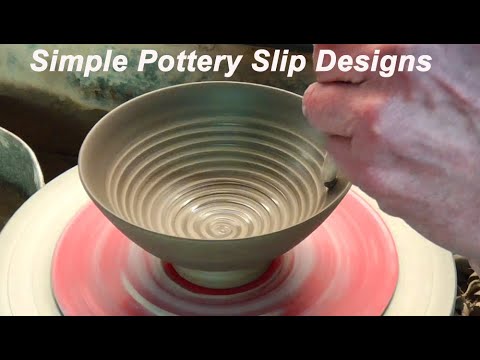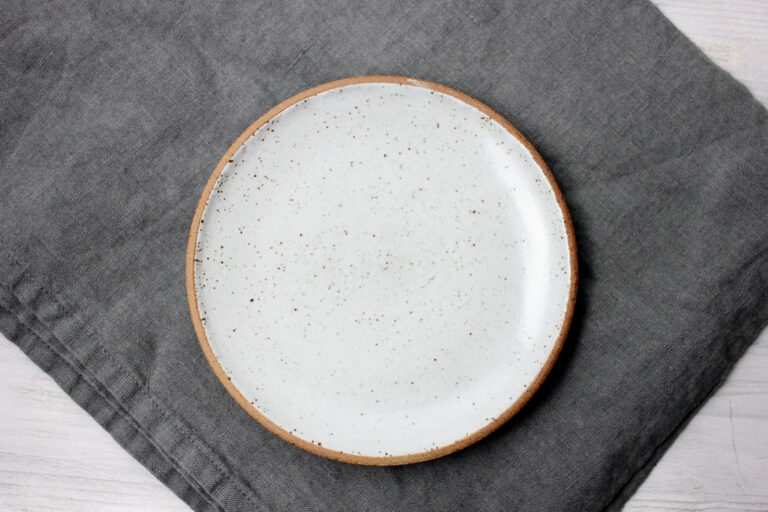
As the name suggests, glazing your pottery basically means you are covering it in glass. Simple, right? Well, it may not be as simple as it sounds. There are many different types of ceramic glaze and there are important considerations when you are choosing a pottery glaze. After all, you want to make sure you get beautiful results.
Choosing a pottery glaze requires the following considerations. What temperature you are firing to and how do you want to use your ceramics. Is your pottery going to be decorative or functional? Also, there are aesthetic questions. Different types of ceramic glaze create very different finishes to pottery ware.
So, choosing a pottery glaze involves practical and artistic considerations. The artistic element of glazing your pottery can be very exciting and rewarding. It’s a wonderful feeling to produce something that looks lovely. So, an understanding of the different types of ceramic glaze available is a great starting point.
Choosing a Pottery Glaze – Some Practical Considerations
Although thinking about the way your pottery will look is exciting, it is best to deal with the practicalities first. So, let’s have a look at some of these practicalities…
The Temperature You are Firing to Determines the Types of Ceramic Glaze You Can Use
Like clay, glazes are fired at different temperatures. Glazes need to reach a certain temperature to melt and bond properly to the ceramic it has been applied to.
Different firing temperatures are referred to as low fire, mid fire, and high fire. As the names suggest, ‘low fire’ is in the lower temperature range. ‘High fire’ clays and glazes are in the higher temperature range.
Often these different ranges are referenced by using the cone rating system. Cones are small cone-shaped pieces of ceramic that are placed in the kiln. Cones have different melting points and are numbered according to the temperature at which they bend and eventually collapse.
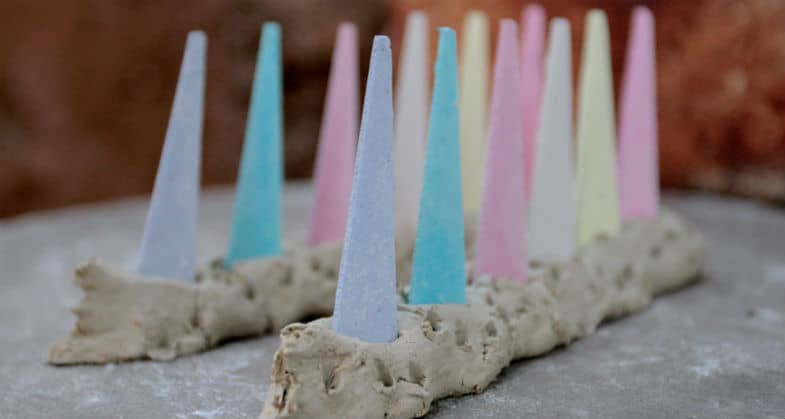
The lowest cone number is 022, which melts at a temperature of around 1112F (600C). The highest cone is 10, which melts at around 2381F (1305F). There are cones that go above 10, but most commercial ranges go up to 10.
Temperatures between these two ends of the spectrum are given a different cone rating ascending from 022 to 10.
Like clay, glazes are categorized by the cone system. This will let you know what temperature range the glaze can be fired to. When choosing a pottery glaze you need to select one that fires at the same temperature your clay body.
Choosing a Pottery Glaze According to Its Firing Temperature Range:
Low Fire Glazes
- Low fire temperatures range between 1830-1940F (999-1060C).
- This is generally cone 06-04
- Low fire glazes can produce strong colors without needing as much power to fire. This makes them an economical option.
- There are many low fire commercially produced glazes available.
Mid Fire Glazes
- Mid fire temperatures range between 2157-2232F (1186-1222C).
- This is generally cone 4-6.
- In the past, mid fire and high fire glazes were used to create pottery with earthy more subdued colors. However, as glazes have advanced, it is possible to achieve vivid colors in this range. Also, an advantage of these glazes is that they tend to be strong. This makes them good for functional purposes.
- There are also many mid fire commercial glazes available.
High Fire Glazes
- High fire temperatures range between 2305-2381F (1263-1305C).
- This is generally cone 8-10.
- Electric kilns are not often used at the high firing range. Partly because it draws so much electricity to do so. High firing is normally done in gas kilns. And as there are fewer gas kilns used, there are also fewer commercially produced high firing glazes on the market.
- However, potters are often as generous as they are inventive. And it is not uncommon for ceramicists to share high fire glaze recipes on forums.
Overfiring Your Glaze:
Firing glaze above a temperature that it is designed best for is called ‘overfiring.’
Overfiring a glaze can create problems with the finished article. For example, it can cause the clay to melt too much and slide down the pottery.
The result is that you get an accumulation of glaze at the bottom of the ware. Consequently, the layer of glaze at the top will be relatively thin.
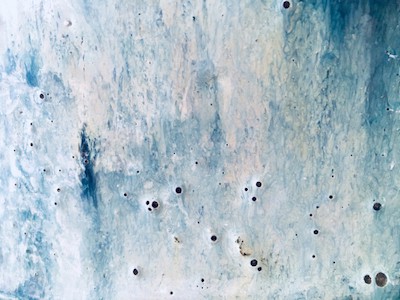
Or you might get blistering and something called pinholing. Pinholing is the occurrence of small holes in the surface of the fired glaze.
These holes happen when bubbles burst in the glaze as it is being fired. The holes go down to the surface of the underlying clay.
A similar problem is pitting. This is similar to pinholing, but the holes are shallower and don’t go all the way down the clay surface.
Each of these problems can be caused by firing a glaze beyond the temperature at which it is ideally suited. The temperature range of a glaze depends on its ingredients.
Consequently, you can’t apply a cone 06 glaze to clay that needs to be fired in the high fire range. If you do, the glaze is likely to be ruined, along with your pottery.
Choosing a pottery glaze that is right for your project means selecting one that is compatible with your clay.
Underfiring Your Glaze:
Similarly, glazes do not fare well if they are ‘underfired’. Underfiring, as you might have guessed, is when the glaze is not heated sufficiently in the kiln.
The result of underfiring glaze is that it can look cloudy and dull or matte. It can also have a rough texture, a bit like a piece of glass that’s been washed up on the beach. This is because the melting process has been interrupted before the glaze is fully ‘mature’ or melted.

If your glaze is underfired, it is possible to re-fire it to complete the process. However, this is only possible if the underlying clay body can be fired to a higher temperature too.
As such, it’s not a good idea to put a high fire glaze on a low fire clay body. Generally, the clay that you are using will give the firing temperature range on the bag it is delivered in.
When you are choosing a pottery glaze, just make sure that the glaze fires within the same range.
One of the reasons for this is that as the glaze melts, it interacts with the underlying ceramic. As the liquid glaze and clay interact, they form an intermediate layer.
The more the glaze and clay mingle in this layer, the better the bond will be.
Bonding between glaze and clay happens best when both reach a peak in the firing process at the same time.
Choosing a Pottery Glaze – What Type of Kiln are you Using?
The two kinds of kilns that are most common are electric kilns and gas kilns. There are lots of different ways of firing pottery and some of them have extremely beautiful results. However, if you are relatively new to glazing ware, you are likely to be using either gas or electric.
Of the two, electric kilns are by far the more common. One of the reasons for this is convenience. Electric kilns are normally smaller and don’t need venting. Whereas a gas kiln is usually larger and needs an air inlet and a flue. Electric kilns are also normally cheaper to buy.
However, most potters when they start off don’t have their own kiln. They will often borrow or hire a kiln firing service.
So, it is not impossible that you might find yourself firing your ware in a gas kiln. Perhaps you have a potter friend with a gas kiln who has offered to fire some of your work. Or maybe a local potter has agreed to help you out.
The reason this is relevant is that glazes can look different according to how they are fired. A glaze fired in an electric kiln can look quite different from the same glaze fired in a gas kiln.
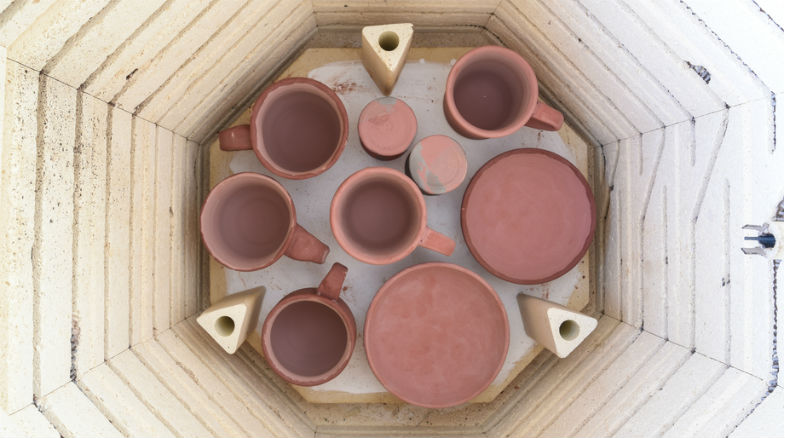
Oxidation and Reduction
Electric and gas fired pottery can look quite different because of chemical processes that happen during firing. These processes are called oxidation and reduction. The different firing environment created depends upon how much oxygen is present in the kiln atmosphere.
Generally, a ‘reduction atmosphere’ can be created in a gas kiln, not an electric kiln. Electric kilns tend to work with an oxidation atmosphere.
Glazes fired in the oxidation atmosphere of an electric kiln tend to be clean bright colors. The same glaze in a gas kiln where the oxygen level has been reduced may look more earthy and organic. A reduction atmosphere tends to create darker more intense glazes.
Whilst all of this might seem a bit overly technical if you are just starting out with glazes. It is worth being aware of it, as it might affect your decision when choosing a pottery glaze.
Choosing a Pottery Glaze – Decorative or Functional Glazes?
You may want your ceramics to be functional dinnerware that is suitable for eating off and cook in. Or you may want your pottery to be decorative, like an ornament or a vase.
If you want your ware to be functional, your glaze needs to be food safe. The question around food safety and pottery is complex and is under increased scrutiny. Suffice to say it’s an important factor when choosing a pottery glaze.
I am neither a chemist nor a medic. So, I’m not qualified to make any definitive statements about food safety and pottery.
However, I am aware of the following. Often glazes that are matt or non-glossy are classified by glaze suppliers as non-food safe. This is because there is a risk that these surfaces may harbor bacteria. The same is true of crackle glazes, which by their nature have tiny cracks on the surface.
Another issue that is important in this area is the leaching of toxic substances from glazes into food. One particular such substance is lead.

Choosing a Pottery Glaze – Lead or Lead Free Glaze?
The presence of lead in glaze is associated with bright colors and glossy surfaces. However, it is also linked to health concerns.
A direct quote from the Department of the Environment and Energy of the Australian Government puts it succinctly. They state:
“Lead used in ceramic glazes covering the surface of ceramics can be a health hazard for potters, and people using their products.”
They continue:
“This is because the lead can get into food and drink prepared, stored, and served in the crockery.”
This is a sobering thought and important to be mindful of when deciding which types of ceramic glazes to choose. Almost all glaze suppliers will state clearly in their product description whether a glaze contains lead or not.
Lab Testing Your Glazes?
It’s often assumed that if you use lead free glaze then your ware will be safe for functional use. However, some suppliers sensibly state that the term ‘food safe’ can’t be applied to glaze as it is supplied.
This is because whether a piece of pottery is food safe depends on other factors. These include, amongst other things, how the pottery was fired, the texture of the ceramics, and what clay was used.
Generally, it’s thought that ware will be food-safe if a lead-free glaze is fired to maturity. And if a suitable clay body has been used. However, increasingly suppliers recommend that food safety can only be guaranteed if the ware has been tested in a laboratory.
There are certified ceramics testing laboratories that will test a potter’s ware for leaching. This may sound like a tedious procedure. However, actually sending off a sample to be tested can be relatively straightforward.
As a rule, if you are making functional ware, choose a lead-free glaze. However, if you and your family are choosing to eat from it, it may well be worth getting it tested. This applies if you are selling ceramics you have made too.
Choosing a Pottery Glaze – Artistic Considerations
I stated earlier that choosing a pottery glaze depends on practical and artistic concerns. Now we have covered some of the practicalities, let’s get onto the fun bit….
Clear Glazes
Clear glaze can be applied directly to the bisque clay body. Perhaps you are going for a clean-looking piece of ceramic. Maybe you don’t want to detract from the form of your ceramics with busy colors.
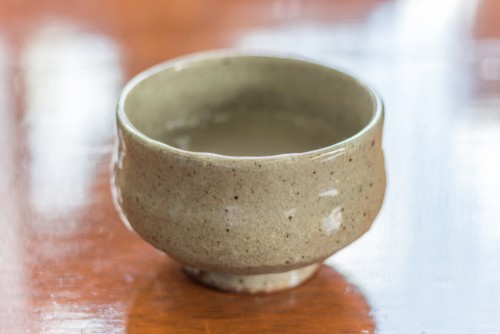
However, if you have used underglaze decoration, choosing a pottery glaze that is clear makes sense. A clear glaze over underglaze decoration will seal the ceramic and make it non-porous.
The colors from underglaze can be quite vivid. And if underglaze is fired correctly it will survive the firing process and remain true to its original look. A clear glaze will brighten and intensify underglaze colors even more.
Technically, you could apply a translucent glaze on top of underglaze. However, most potters use clear glaze over underglaze decoration.
Clear underglaze can be glossy, matte, or satin / semi-matte. It’s really an aesthetic choice which type of clear glaze you choose.
Underglaze colors can smudge when you are adding the clear glaze. There are a few ways that you can fix underglaze so that it doesn’t run.
One solution that potters have found is to spray the underglaze with hair spray or liquid laundry starch. This stops the underglaze from running when the clear glaze is applied and burns off in the kiln when fired.
Another way of avoiding underglaze smudging is to consider how you are applying the glaze. If you are brushing the glaze on, you can minimize smudging by applying the first layer thin and light. Allow this to dry and then build up your layers.
However, there is also the option of dipping. How you are applying your glaze is another factor when choosing a pottery glaze. So, read on….
Dipping or Brushing Your Glaze?
There are a number of ways you can apply glaze. Two of the most common ways are either dipping glaze or brushing it.
Dipping Glazes
When you dip your pottery in glaze, you literally submerge it into a container of glaze. Usually the ceramic only needs to be held in the glaze for around 3 seconds before being removed.
This is a good way to apply an even coat on a piece of pottery quickly. For that reason, it is often used by potters who are producing larger quantities of pottery.
However, in practice, it usually involves having a larger quantity of glaze in a bucket or container. You can dip into smaller or shallower containers but this can be a bit fiddly.
Ready-made dipping glaze is often sold by the gallon. If you are relatively new to glazing, you may only have a few pieces to glaze. As such, buying a gallon of glaze may not be practical, necessary, or economical.
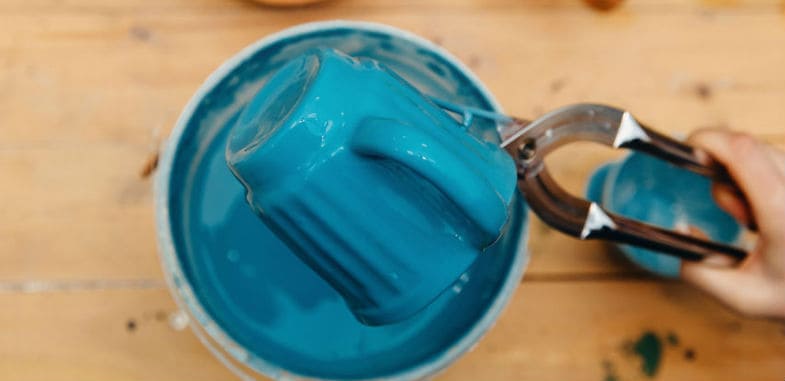
Brushing Glazes
Fortunately, you can buy brushing glaze which normally comes in smaller quantities. Brush on glazes tends to be thicker in consistency than dipping glazes.
Most brush-on glazes are formulated so that the brush marks will even out when applied. However, this is not always the case, so if you brush on, you may need to be careful to apply evenly. Unless of course, the brush marks are an intentional part of your design.
There are glazes on the market that claim to be suitable for dipping and brushing. Often, they will specify that if you are dipping you need only apply one coat. However, if you are brushing it on you need to apply 2 or 3 coats.
These glazes do tend to be thicker than glazes that market themselves as dipping glazes. However, fortunately, glaze can be thinned down by adding water until you have the consistency you need.

Powdered or Readymade Glaze?
Glaze can be bought in a readymade-up liquid form, or in a powder that needs to be mixed with water before using. Buying powdered glazes can work out cheaper in the long run. However, the convenience of buying it ready-made may be an important factor for you in choosing a pottery glaze.
If you are new to glazing, the idea of mixing your own glaze may feel a bit daunting. You may just want to press on and experiment with readymade glazes. At least with a readymade glaze, you are relatively certain that the consistency and thickness will be right.
However, if you are feeling bold, you can mix your own. Most manufacturers will supply their own mixing instructions and ratios of water to powder. However, at its simplest, mixing powdered glaze involves mixing the powder with water and passing it through a sieve.
The sieve is designed to smooth out any lumps in the mixture. However, some glazes are designed to have a speckled effect. If you are using a speckled glaze the residue in the sieve needs to be returned to the mixture. This is because it is the gritty residue that creates the characteristic speckled effect.
If you are mixing your own glaze you can either make dipping glaze or brushing glaze. The glaze is made into brushing glaze by adding a thickening medium.
Each different glaze supplier is likely to have its own brand of thickener. Generally, they will advise on what ratio of thickener to glaze is needed to create a brush on glaze.
Colored Glazes
There are endless types of colored glazes to choose from. It’s really a matter of personal choice what color scheme appeals to you.
Generally, it is fine to apply layers of different colors of glaze on one piece of ceramic. Layering different glazes can create beautiful and individual results.
If you are layering glazes, it is good to be mindful of the temperature that they mature at.
Layering a low fire glaze with a high fire glaze may turn out looking a little odd. With either one of the glazes suffering depending on what temperature you choose to fire at.
On the other hand, your intention may be to create an odd-looking glaze! It really is a matter of personal choice.
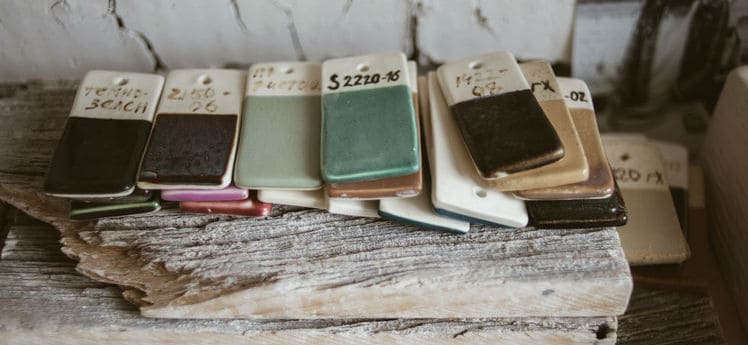
Bear in mind that raw glazes in their unfired state will look very different after they have been fired. The same glaze can look quite different when fired at different temperatures. Also, depending on the opacity of your glaze, the color of your clay will affect the color of the glaze.
Sometimes your ceramics will look quite different after firing to the sample piece used by the supplier for illustration purposes. This can be disappointing or exciting, depending on how much you like the results.
Glazing pottery can produce unexpected results depending on a number of variables. I sometimes think the best way to approach it is to have a Zen-like attitude. Perhaps the key is not to be too attached to the outcome and embrace the unexpected!
Opaque or Transparent Glaze?
Another factor to consider when choosing a pottery glaze is whether you want it to be opaque or transparent. If you use a transparent glaze you will see the clay body and any underglaze decoration through the glaze.
It’s worth bearing in mind that transparent glaze darkens (or intensifies) the color of the clay and underglaze. If you choose a transparent colored glaze this can muddy or comprise the color of an underglaze design.
Having said that, if you combine the color of your underglaze and glaze wisely, the resulting combination can work well.
Opaque glazes, on the other hand, will block out the color of the underlying clay body.
It’s also possible to get semi-transparent glazes that partially block out the underlying clay or decoration.
Breaking Glazes
Some glazes are formulated specifically so that they become thinner over raised areas on a piece of pottery. The idea is that these glazes highlight different textures on the surface of the ceramic.
Breaking glaze can bring out a pattern that has been incised on the clay surface. The glaze will become thinner on raised areas and contours. And it will thicken or pool in recessed areas.
If the clay body is a different color from the glaze the incised design is highlighted even more clearly. For example, an incised pattern can become a strong feature if a dark glaze is applied to a light-colored clay.
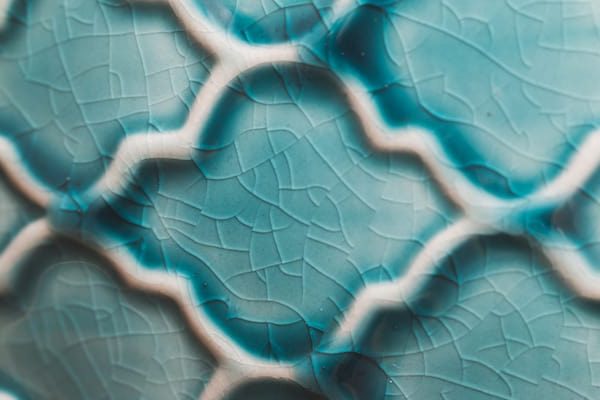
Flowing Glazes
As their name suggests, flowing glazes become quite fluid and move about when they are fired. They are usually applied in conjunction with other glazes. Often, they are used on top of or below other types of glaze. When they are fired, they bleed and move into the other glazes next to them.
Flowing glazes are normally fired at lower temperatures. Typically, they fire to cones 06-05. However, they produce an effect that looks like the kinds of glazes achieved at higher temperatures. So, they are a good way for potters to recreate a high fire look, whilst using low fire temperatures.
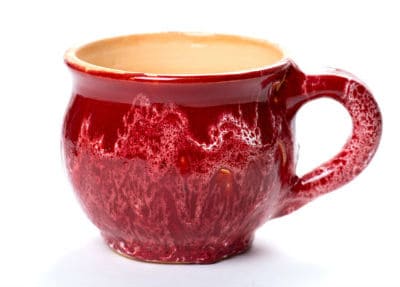
You can exercise some control over how a flowing glaze turns out by applying it in a particular pattern. However, because of the movement that occurs during firing, each piece will look different when it is finished.
Glazes that stay put when they are fired, and flow or move less are described as being ‘stiffer’. Choosing a pottery glaze that is stiffer will give you more control over how your pottery looks.
Textured Glazes
Typically glazes come in gloss, matte, semi-gloss and semi-matte, and satin matte. However, there are certain glazes that are specifically manufactured to have a unique textured finish.
One of the most common of these is ‘crackle glaze’. Crackle glazes are designed to give a crazed effect once fired. The crazing can range from a faint subtle effect only visible on close inspection. Or it can be quite bold and distinctive.
However, other textured glazes are available if you are interested in creating a particularly textured effect. Textured glazes can give pottery a pitted, cobbled, mottled, or frothy look.
Alternatively, you can use application techniques that will create interesting glaze textures too. Have a look at this video for inspiration if you are feeling bold and experimental.
Raku Glazes
Raku is a particular method of firing pottery. In Raku, the pottery is taken out of the kiln with tongs when it is red hot. The ceramics are then put into a combustible material and covered over to create a reduction atmosphere.
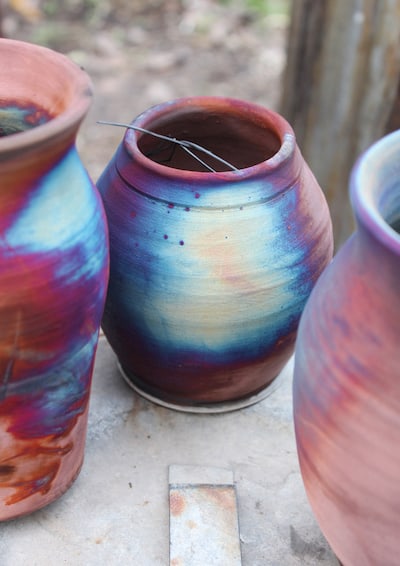
Because of the sudden drop in temperature, glazes will typically crack. And the carbon from the combustible material will embed into the cracks in the glaze.
This creates dark-colored crazing sometimes set against light-colored glaze. This is a very distinctive raku look.
Technically a raku glaze is any glaze that is used in a raku firing. However, there types of ceramic glazes that are specifically developed to enhance the raku effect when fired. They often have metallic lusters and crackle patterns.
Many raku glazes can be fired in an electric kiln in an oxidizing atmosphere. However, if they are used for raku firing they will look quite different afterward.
This is partly because when the ceramics are sealed in with a combustible, a reduction atmosphere is created. Generally, they have earthier colors, metallic tones, and speckling or a crackle effect.
Choosing a Pottery Glaze – Luster Overglazes
These glazes create metallic and iridescent effects on ceramics that have already been glazed and fired. The luster glaze is applied to the glazed surface and then the ware is fired again at a low temperature.
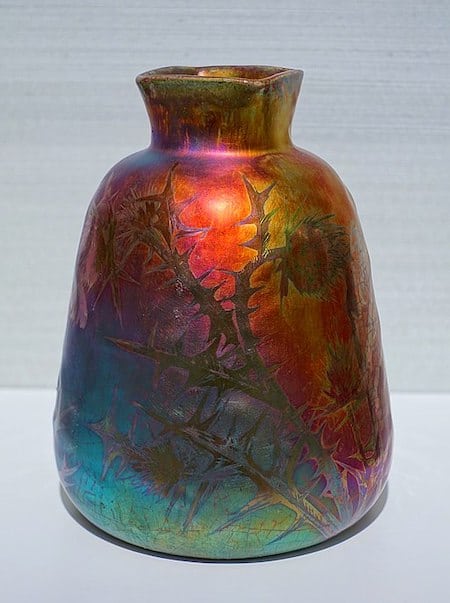
Luster glazes need to be fired between cone 018 and 016.
The reason for this is to avoid the existing glaze on the ceramic surface from softening again. If the underlying glaze begins to melt, then the look of the luster glaze will be compromised.
Luster glazes are designed with refined ingredients that melt at a low temperature. Like other glazes, they can be dipped, painted, and sprayed on.
It’s also possible to get luster pens to draw the luster glaze onto your glazed ceramic.
Luster overglazes are a nice touch if you want to add a bit of opulence or pizzazz to your ceramics.
Final Thoughts
There is a lot to consider when learning how to glaze your pottery. Like all aspects of ceramics, it is a mixture of practical, technical, and artistic skills. Glazing, more than any other part of ceramics involves a degree of the unexpected.
Although you can exercise some creative control by choosing different types of ceramic glaze, there are many factors at play. These will determine how your pottery emerges from the kiln.
As you are learning your craft, it’s a good idea to embrace the unexpected. Choosing a pottery glaze that matches your personal taste and skill level can help. However, often, surprising results are even more beautiful than what we had envisaged or intended.


